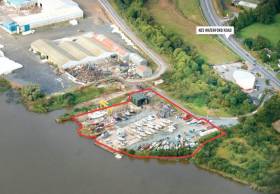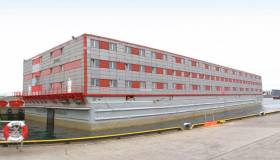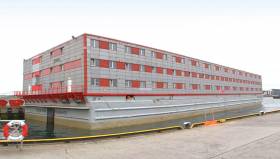Displaying items by tag: property
Former Crosbie Property at Dublin Port Taken Over by State for Post-Brexit Checks
#dublinport - At Dublin Port freight requiring physical checks after Brexit will, writes The Irish Times, be inspected in a warehouse formerly owned by businessman Harry Crosbie following an agreement signed by the State.
As part of contingency planning for the United Kingdom crashing out of the European Union without a deal next month, Dublin Port Company has signed a licensing agreement with the Office of Public Works to hand over use of a port-owned 13,000m warehouse on a five-acre site at the northeastern part of the port for Brexit-related checks.
The departure of the UK, the State’s closest trading partner, from the EU will lead to a huge increase in the number of UK imports requiring customs, health and safety clearance on their arrival into the port.
Eamonn O’Reilly, the port’s chief executive, confirmed it had licensed the property on Tolka Quay Road to the State, and that the OPW was fitting out the former Crosbie warehouse property and another seven-acre inspection area to be ready for Brexit-related checks after the UK’s departure on March 29th.
For more on this development, click here.
#Property - A sea view in scenic Greystones is just part of the appeal of Rowan Point at the Wicklow town’s Marina Village development.
The first phase of 58 apartments is now for sale off plans, with views either north to Bray Head, east to the sea or west to the Sugarloaf.
Prices range from €425,000 for first floor units to €950 for penthouses, and unique touches include local stone countertops.
The Irish Times has more on Rowan Point’s first phase HERE.
Galway Greenlights Student Housing In Docks
#Property - Galway City Council has granted permission for the construction of new student accommodation on the former Topaz oil site in Galway Docks, as Galway Bay FM reports.
Two blocks of seven and eight storeys each would provide 345 bedrooms as well as space for business start-ups in the plans by Bonham Dock Limited.
However, a number of restrictions have been attached to the project, which constitutes a phase of the masterplan for a ‘New Galway’ between the docks and Ceannt Station rail yards.
Back in September, ambitions plans for floating student accommodation in the city’s cocks were ruled out by the Galway Harbour Company, as previously reported on Afloat.ie.
Busy New Ross Boat Yard Comes To Market
#Property - New Ross Boat Yard in Co Wexford is now on the market at a price point of €4 million.
With 230 metres of frontage on the River Barrow and easy access to the Nore and Suir (and by extension the South East Coast), the 1.62-hectare property also comes with a sizeable dry dock, one of only three in the Republic that can handle large commercial boats.
Additionally on the site is a 50-tonne marine travel lift and winter storage space or as many as 150 vessels, thanks to signifiant refurbishment over the last decade by its present owner.
With an annual turnover of €840,000, and planning permission in place to adapt the dry dock for year-round service, the boat yard is sure to be an attractive prospect.
No Go For Student Barges In Galway Docks Says Harbour Chief
#Galway - Galway Harbour Company has ruled out any notion of floating student accommodation in the city’s docks.
According to Galway Bay FM, harbour CEO Eamon Bradshaw said lack of space in the inner docks was the reason for rejecting the proposal by a local property management firm in an effort to alleviate the accommodation crisis facing NUI Galway students.
Last month Winters Property said it was in talks to bring to the city two purpose-build apartment barges, with a capacity of more than 400 between them.
The company’s managing director Enda McGuane also said he was discussing the possibility of mooring at the private Mud Dock owned by Capt Sam Field-Corbett, the champion of waterside accommodation behind the Naomh Eanna restoration.
Floating Apartments Proposed As Solution To Rental Crisis In Galway
#Galway - A property management firm in Galway believes a solution to the city’s rental crisis for students could be found in the form of large-scale floating accommodation, according to The Irish Times.
Winters Property says it could have two such purpose-built apartment barges, with capacity for more than 400 NUI Galway students between them, in Galway Docks within weeks.
The barges are developed by Liverpool-based Bibby Maritime for use in the oil and gas sector and corporate events, and the company currently has two such vessels available.
But planning permission is another matter, with berthing space at a premium in the city and priority given to commercial traffic.
Winters Property’s managing director Enda McGuane says he is in discussions with Capt Sam Field-Corbett, waterside accommodation advocate behind the Naomh Eanna restoration, about the feasibility of using his privately owned Mud Dock as a mooring location.
The Irish Times has much more on the story HERE.
Cork Docklands Site Comes To Market
#CorkHarbour - More than three acres of Cork docklands are coming to market, as the Irish Examiner reports.
The lands comprise a warehouse property between Monahan Road and Centre Park road east of the city centre, in an area already set for transformation between the revamped Páirc Uí Chaoimh and the new Marina Park regeneration project, adjacent to Cork City Marina by the former showgrounds.
Commercial and residential developers alike are expected to express interest in the 3.31-acre site, zoned for mixed use, and with a guide price of €1.2 million per acre.
Interest in this part of the city is growing with the imminent move of the Port of Cork downriver — and city planners are already meeting with potential buyers for the port’s historic buildings on Custom House Quay.
The Irish Examiner has more on the story HERE.
Barna Family Home Boasts Galway Bay Views
#WaterfrontProperty - The Galway Advertiser has details of a detached family home near Barna with views over Galway Bay on the market for €570,000.
The waterfront house sits on a half-acre site and comes with spacious rooms featuring south-facing windows, designed "to allow free flow" through the home.
Also worth noting is the large attic with potential for conversion, ad the planned gardens between the house and its spectacular vista over the bay.
The Galway Advertiser has more on this property HERE.
Booterstown Site Asking For A Million
#Property - A prime seafront site in the South Dublin suburb of Booterstown is on the market for €1 million, as the Irish Independent reports.
Located between the Rock Road and the Dart line and adjacent to the nature reserve, the five-acre site is described by agents Knight Frank as a "unique development opportunity" with "spectacular" views of Dublin Bay.
The lands comprise two areas zoned 'objective Z9' and 'objective F', both of which require preservation of open space and recreational amenity under the respective developments plans of Dublin City and Dun Laoghaire-Rathdown councils.
The Irish Independent has more on the story HERE.
Welsh Marina For Sale - Just £2.5m For The Lot
#WaterfrontProperty - Aberystwyth Marina and its 150 berths in West Wales are on the market, and the whole lot could be yours for just £2.5 million (€2.9 million), according to Wales Online.
The 23-acre marina, which has planning permission for an extra 40 boat moorings, reportedly has an annual turnover of more than £300,000, and is the first marina in the UK to be available on the open market for more than five years.
Located on the banks of the River Rheidol as it flows into Cardigan Bay, Aberystwyth Marina has the added benefit of being just a day's crossing of the Irish Sea from the East Coast of Ireland and our bustling sailing scene.
But pretenders beware - current owner Merlin Developments is only looking to sell the business to an experienced and proven operator.
Wales Online has much more on the story HERE.







































































